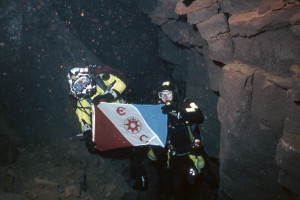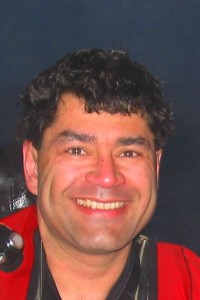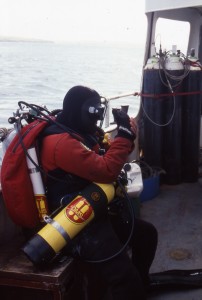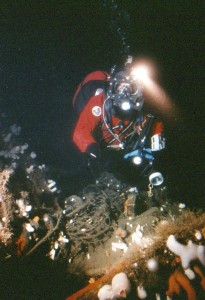Although probably best known for his classic true tale of fatal father-and-son diving hubris, ‘The Last Dive‘ (Hardcover: 368 pages, Publisher: Harper; First Edition (October 3, 2000) ISBN-10: 0060194626), Bernie Chowdhury is also a Fellow of the Explorers Club who has helped map underwater caves in Iceland and dived deep wrecks below 300 ft. and a member of AAUS, the American Academy of Underwater Sciences.
I caught up with him recently to ask him some questions about both the book and what he has been doing since then.
Interview by Michael Bear
Q: You are probably best known as the author of the diving classic ‘The Last Dive: A Father and Son’s Fatal Descent into the Ocean’s Depths,’ the story of Chris and Chrissy Rouse, an infamous and combative father-son dive team who met with disaster while attempting to explore a German U-boat 230 feet deep in the waters off New York, which was a best-seller in diving communities on both coasts.
We promised not to dwell on your book, since you have done many interesting things since then, but we have to ask at least one or two questions about it–hope you don’t mind.
Q: Why were the Rouses so combative with each other, as anyone ever figured that out? Was it just a classic father-son competition thing, or was there more to it, in your opinion? There is some speculation that the constant goading of Chrissy Rouse by his father led to his wanting to ‘prove something’ to him on their final dive.
A: The reader can draw their own conclusions about the Rouses from my book. I do discuss the different viewpoints about their behavior.
There are many lessons to be gleaned from the diving incidents and scenarios in my book. What has been very rewarding for me as an author and diving instructor has been the many positive responses I’ve gotten from divers who’ve let me know how much they’ve gotten from the book. In some cases, divers have told me that they’ve re-read The Last Dive on several occasions and gotten new insights on subsequent readings. Many father and son teams have spoken to me at dive shows, or have written to me and let me know that my book has given them insights into their diving and also into their overall interactions. I’d like to think that the Rouses’ deaths served a higher purpose as a cautionary tale and as insight into the complex dynamics of any parent-child relationship, especially as it pertains to undertaking physical activity that can potentially be dangerous.
Q: They chose to make their final dive to 230 ft. on regular air, rather than Trimix or other gas mixes, which were available at the time, and there is some evidence that the narcosis they experienced on their dive contributed to their deaths. Did they really choose to fill their tanks with air on that dive to merely to save money? Weren’t they aware of the potential disastrous consequences of doing such a deep, penetration dive like that on air?
A: As I stated in my book, my last conversation with Chrissy and Chris Rouse was two weeks before their last dive. I was shocked when Chrissy told me they were planning on using air and what their dive plan was. I asked him to put his father on the phone, and he repeated what Chrissy had just told me. I tried to talk them out of using air, especially since they were trained (by Sheck Exley) in Trimix, and also mixed their own gases. In all of the interviews I did for the book, and also since then, all of their close friends with whom I had been in contact told me that they had had similar discussions as I had had with the Rouses before their fatal dive. Yes, they chose to use air rather than Trimix. The reason they gave me – and others — was that they wanted to save money.
Q: What got you into diving originally?
A: When I was very young, maybe 7 years old, I was visiting my grandmother in Berlin and she bought me a set of snorkeling gear. I taught myself to snorkel in one of Berlin’s lakes and would spend hours in the water. The fins really transformed me and gave me the sensation that I was flying; they really made me feel like I belonged in the water. Without fins on I realized how inefficient I am in the water.
Today, when teaching any level of diving, one of my challenges is to ensure that students swim using only their fins: none of this waving and flapping the hands around to turn or to try and maintain your position in the water column. That’s just inefficient. Besides, divers need their hands free to manipulate things like lights, reels, cameras and all sorts of other stuff.
Q: Perhaps not so well known about you is that you have been a Fellow of the Explorers Club since 1995 and carried the Club flag on your Icelandic Cave Diving Expedition, the first expedition to survey and map of Iceland’s underwater caves, including the Silfur Hellir cave–a tectonic plate dive to 197 feet/60 meters and the Kerauga cave. What was that like, surveying and mapping the underwater caves of Iceland?

Bernie Chowdhury and Villi Hallgrimsson with Explorers Club Flag 193, Silfur Hellir cave, Iceland. Credit: Erlendur Gudmundsson
A: Cold. To my knowledge, we are still the only team to have surveyed and mapped any of Iceland’s underwater caves. I chose Silfur Hellir cave based on my initial scouting trip there and also on the subsequent pre-documentary scouting trip that I did with Canadian underwater cameraman Terry German. (I’ve been diving in Iceland on three separate trips.) As far as I know, Silfur Hellir is the only diveable cave system in the world formed as a direct result of tectonic plate rifting; the North American plate and the European plate are moving apart at almost one inch per year. When my Icelandic buddy, Erlunder Gudmundsson, told me about the forces at work at Silfur the first time he took me diving there, I found it hard to comprehend and I did some research about it. That’s when I decided to form a team, and come back to map and film it. Canadian Kim Martin and the late American cave diving instructor Steve Berman were the ones who conducted the survey. We printed maps and I donated a bunch of them to the National Association for Cave Diving (NACD), a U.S.-based cave training organization, plus I gave a copy to the folks at Thingvellir National Park, where Silfur Hellir is located in Iceland.
The water temperature (36 F) limited us to about 90 minutes in-water time per day. Geology also limited us: I had initially wanted to survey Kerauga cave, in addition to Silfur Hellir. On my initial scouting trip, Icelandic cave diver Palmi Dungal took me to Kerauga, which he had previously explored. It was a challenging site for several reasons. First, I had to drag my gear and myself into a small cavern-like area and then suit up while standing in waist-high water. American diver Tom Easop, who is not cave certified, helped me suit up, otherwise it would have been difficult — if not impossible — given that I wore three layers of various dry suit underwear.
I knew going into a restriction very close to the entrance of Kerauga that the possibility of collapse and being buried alive was very real. I literally had to dig my way through the small, sharp lava rocks that were underneath a massive boulder so that I could squeeze into the cave. I knew then that some sort of geologic tremor could have closed that entrance in a split second. It was a real gut-check moment; I decided that since I was there I would continue in the name of exploration. Nothing ventured, nothing gained, right?
It took me two set-up dives so that I could push an extra tank into the cave, and also get the scooter in. Palmi loaned me his scooter which was needed to battle the very strong current and make headway. Kerauga is a long lava tube, with three break-down rooms at the then-explored maximum distance of roughly 1,000 feet. In the event, I was able to add another 150 feet of line to the cave after figuring out how and where the system went by making it past many breakdown boulders. I also retrieved Palmi’s reel, which he had purposely left in the cave after winding out all of his line during his exploration.
On the scouting trip with Terry German, we found that the entrance to Kerauga had totally collapsed. This was probably the result of volcanic activity and / or earthquakes, both of which happen very frequently in Iceland. It was sobering, to say the least.
Q: What was it like diving the German cruiser Blücher, a Admiral Hipper class of heavy cruisers of the WWII German Kriegsmarine, which was sunk by shore fire and torpedoes and lies at the bottom of Oslo fjord in Norway, at 307 ft?
A: I was put on the Blücher by the Norwegian Technical Diving Society (NTDS), which was founded by Ronnie Arnesson and Mange Overrein. This was back when the internet was not as ubiquitous as it is today, so I had to write actual letters (remember those?) and it took me some time to find divers who would support my hoped-for dives to the wreck. The NTDS had already been exploring the Blücher, though they had not done a great number of dives on it because of all the logistics. I had previously been diving up in the Norwegian Arctic at Narvik (great WW II wreck diving up there!) and so Ronnie and Magne made inquiries with the guys up there about my diving and were convinced that it was OK to consider taking me to the Blücher. First, they put me on the stern section of SS Edith, which went to 215 feet. That was back when this was an air dive, and oxygen was used for deco. I did the solo dive to my plan of two hours and fifteen minutes run time — yeah, max depth of 215 — and then they gave me the green light to dive the deep wreck.
The NTDS used three small support boats to put me on Blücher, which rests in the middle of Oslofjord, a very heavily trafficked shipping artery, and not overly wide. It’s similar to the St. Lawrence River, between Canada and the U.S. Unfortunately, because of some of the guys’ work schedules, no one was available to dive with me. Magne Overrein was my support diver with the responsibility of placing an extra deco bottle at 70 feet, and then checking on me during my decompression. The NTDS limited me to only 17 minutes bottom time, which was a bit disappointing, though I was happy just to get on the wreck. It was far too short a time, really. The wreck is ‘turtled’ up-side-down. There was a large opening that I wanted to penetrate, but it was just too short a time to do it safely and still make my run time schedule. The water was totally dark on both the Edith and on the Blücher so that my dive light was like a Star Wars light saber, which was a cool effect. On the Edith that sensation may have been attributable to the deep air thing (narcosis) but I was on Trimix on the Blücher and still had that light saber feeling, which was pretty cool.
My first decompression stop was at 200 feet, though only briefly to switch gases. On my 20 foot stop (surface supplied oxygen), it got totally black above me, and then I saw massive flashes and large booms that actually shook me underwater. I actually thought that a war had broken out! The guys yanked me off of my stop and when I hit the surface they were frantically getting the boats ready to beat a hasty retreat because of a massive, unpredicted storm that unleashed itself on the fjord. They threw me a rope and towed me in full gear back to the relative safety of a small island. Because they had to yank me off of the 20 foot stop, I got skin bends on my chest, but that resolved after surface breathing oxygen. It all came down to the safety of the group, and having to sacrifice the diver’s safety in the interest of group safety and making sure the boats did not sink, which I fully understand. We can deal with bends, but sinking boats and drowning are another matter entirely….
Next month: Part II of this interview with Bernie Chowdhury
Michael Bear is Featured Contributor for California Diver Magazine, contributor to Marine Science Today, as well as an AAUS (American Academy of Underwater Sciences) Science Diver and founder of Sevengill Shark Sightings.org, a long-term, population dynamics study of Sevengill Sharks.
.
.



